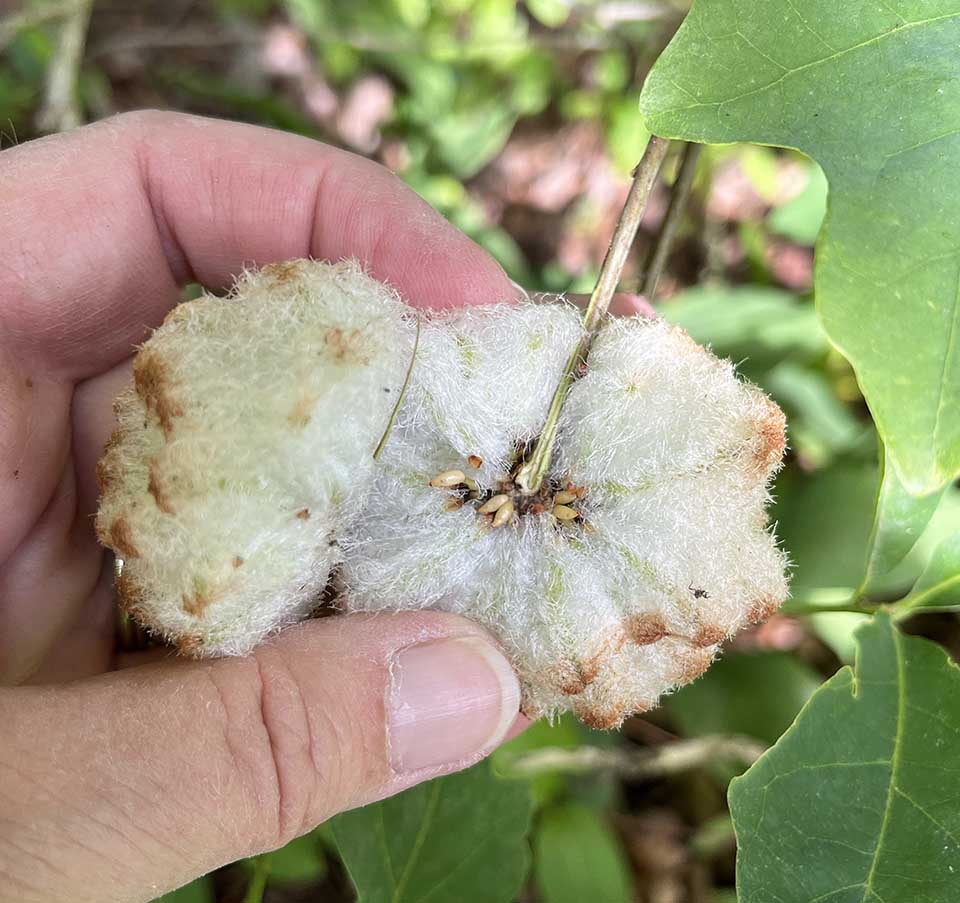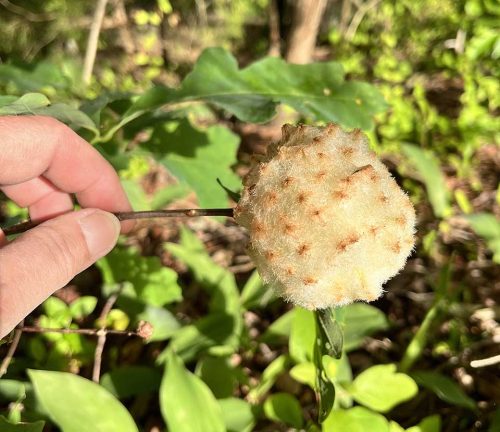Wooly Wonder
What is that marshmallow in my oak tree? Don’t let a little growth gall you (hint, hint!).


On weekdays we have a morning routine that most often involves a neighborhood walk that we extend into Millville’s Laurel Lake area. This jaunt includes my husband, a neighbor, and me. We often identify plants and trees as part of the morning activity.
I suppose because of my interests this often becomes a stump-the-chump exercise of “Hey, what’s this?” On more than one occasion I’ve been stupefied, but this develops into a great opportunity to learn something new. For example, an oak in our neighborhood recently had an unusually large number of what one might describe as cotton balls attached to its branches.
I hear “Huh, look at that!” and the anticipated next utterance is no surprise… “What’s that?”
“It’s a white oak,” I respond, knowing full well that the question is about the cottony growth on the branch. I add, “It looks like a gall. But I don’t recall them being so fluffy-looking.”
Our specimens were golf-ball-sized with brown specks, wrapped around the branch of the tree, with some comrades on adjacent branches—sort of a marshmallow-on-a-stick effect.
These are wool-sower galls, sometimes called oak seed galls. They’re formed by a tiny wasp’s grubs interacting with the host tree. The wasp is called Callirhytis seminator, one of the cynipid wasps of which there are many species. C. seminator also has the common names Andricus seminator, and Cynips seminator. There are 750 species of this insect in North America (Bartlett Tree Experts), and 70 percent of these species make use of various types of oak trees.

Not only do cynipid wasps make galls, but so do nearly 1,500 other insect species in the United States. Some other trees/plants that create galls in conjunction with insect metamorphism include ash, elm, hackberry, honey locust, willow, and witch hazel.
So what are galls? They are abnormal growths on plants that can be found on branches, buds, roots, leaves, or flowers, caused by enzymes given off by immature insects, mites, or grubs. The wool-sower gall is created by a chemical reaction between a cynipid wasp’s grubs and the host tree. The Callirhytis seminator wasp lays its eggs in a ring-like cluster, most commonly around a white oak branch. The eggs become grubs that secrete the enzymes that activate growth on the host tree by interacting with the tree’s hormones.
The growth serves as a protective barrier for the grub while it is in a vulnerable stage of maturation. The fluffy coating also provides nutrients. There are starches contained in galls, along with other resources from the tree, that are beneficial to the transforming insects.
The alternate name oak seed gall derives from the eggs looking like yellowish-white seeds, which are egg-shaped with a pointy end and approximately one-eighth of an inch long. After transforming into a wasp the creature gnaws a hole and emerges from the egg, then navigates its way through the cottony mass that has surrounded it as it matured. The adult wasp that emerges is also about one-eighth of an inch long with a flat abdomen.
One source described the wool-sower gall as being a small group of hair-like galls joined around the egg cluster that, by growing outward, forms the structure we see as a wooly or cottony ball.
Alternate generations create a different type of gall. And there are variants that never form the protective covering over the eggs.
The wool-sower gall does not hurt the tree and the wasp doesn’t hurt people. Most galls are benign and have little effect on trees with the exception of occasional unsightly leaf damage. Cynipid wasps do serve in their various stages as food for fungi, parasites, insects (including other wasps), birds, and small mammals.
In my search for information on oak galls I learned that some species are used to make dyes and inks. A company that specializes in botanical colors sells ground oak galls. They describe the galls from Aleppo oak trees as being high in tannins and an ancient mordant (a substance, typically an inorganic oxide, that combines with a dye or stain and thereby fixes it in a material.).
The Aleppo is native to southern Europe and the Middle East. Its galls provide light beige coloration in conjunction with an alum mordant. When dipped in an iron after-bath the color changes to gray or black. They suggest that the crushed galls can be sifted and stained for reuse.
Galls have been used in leather tanning and have also been employed in medicines to treat fever and intestinal ailments. Some insecticides contain tannic acids from galls.

The Smithsonian Institute suggests that collecting and rearing insects from galls is an interesting exercise for students in science classrooms.
From Smithsonian Bug Info: “Rearing insects from galls is fun and relatively easy. The galls should be kept in a jar or similar enclosure, with some moisture. An option, especially for galls on twigs, is to tie a sleeve of cheese-cloth or muslin around the area to capture the insects that emerge from the galls. Some galls must be kept through the winter because the larvae require winter diapause. Some gall makers leave the galls as immature forms and drop to the soil where they may live out the winter. One can trap these in plastic bags and transfer them to small containers of peat moss that can be left outdoors for the winter and brought indoors in spring to catch the emerging adults. Part of the fun of studying galls is learning about the diverse life histories of the gall makers.”
So possibly you would like to treat a young child to the wonders of metamorphosis—or enjoy being a kid yourself again. The natural world is certainly filled with wonders!
Sources
North Carolina State University, Extension Service
The Scott Arboretum of Swarthmore College
“Cynipid Gall Wasps on Oak,” Research Laboratory Technical Report, by K. Chase and C. M. Rigsby, Bartlett Tree Experts
Callirhytis seminator, Gallformers.org
University of California Agriculture and Natural Resources, Integrated Pest Management.
Botanical Colors, Seattle, WA
Goitein, Shelomo Dov; Sanders, Paula (1967). A Mediterranean Society: Daily life. University of California Press.
Smithsonian, Bug Info, Insect and Mite Galls








